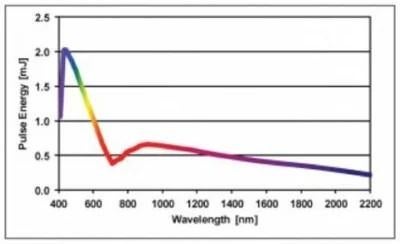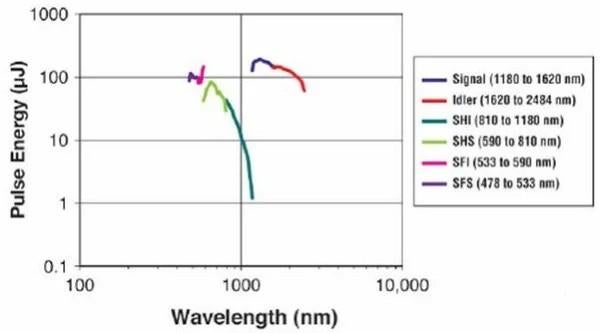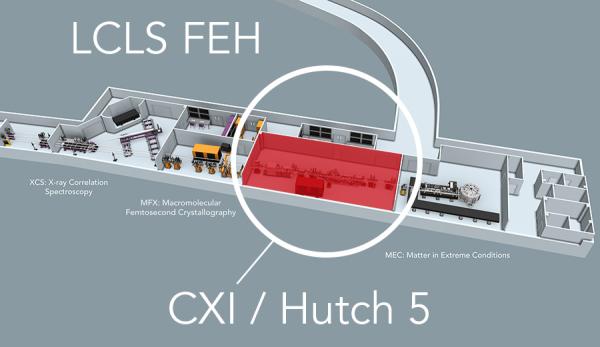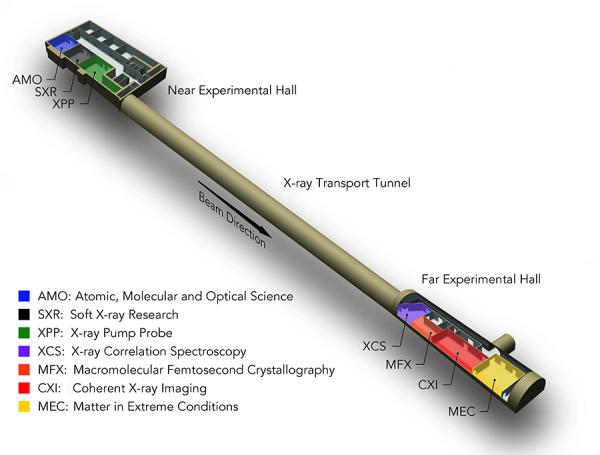CXI Standard Configurations
CXI Standard Configuration for Run 25
Liquid Jets with the CXI 1 micron Focus
Types of Experiments
This standard configuration is tailored for liquid phase samples. It is suited for diffraction (Serial Femtosecond Crystallography (SFX)) and Small Angle and Wide Angle X-ray Scattering (SAXS/WAXS) with or without a pump laser using a wide variety of sample delivery methods, either LCLS-owned or supplied by the user groups. A Jungfrau-4M detector is available for high angle data collection close to the sample with a second detector downstream (CSPAD-2.3M, epix10k-135k) with a well-motivated science case.
X-ray Focus
CXI will be configured to use the 1 micron KB focus. This provides a ~1 micron (FWHM) beam that is not adjustable in size.
Sample Environment
The CXI 1 micron Sample Chamber will be used. It provides a large volume to support devices inside vacuum, including the following which will be supported in this standard configuration.
Liquid Jet Mechanical System
The liquid jet mechanical system is installed on top of the sample chamber. It consists of an XYZ stage to position a shroud in which the sample is delivered. This shroud is part of a load-lock system which allows long nozzle rods to be inserted and removed without venting the sample chamber. Sample delivery systems which are compatible with this mechanical system, load-lock and the standard nozzle rods will be supported with discussion with an instrument scientist. This includes Gas Dynamic Virtual Nozzle (GDVN), Lipidic Cubic Phase (LCP) injectors or other viscous sample extrusion systems, the Microfluidic Electrokinetic Sample Holder (MESH), many types of mixing nozzles and other systems that can be mounted on the nozzle rod. Contact the CXI scientists for details on the nozzle rod and the injector mechanical system.
On-axis Sample Viewing System
The CXI sample chamber will be equipped with an on-axis jet viewing system. This system provides a ~3 micron resolution view of the jet from the perspective of what the X-ray beam sees. This provides a rough alignment of the jet without any detailed information about the sample content or jet size and speed.
Perpendicular High Resolution Jet Imaging System
A high-resolution jet imaging system will be installed to provide a perpendicular view of the jet. A continuous illumination LED will be used to provide the necessary illumination. This LED is currently available at 520 nm, 617 nm or 850 nm.
Post-Sample Attenuator
A post-sample attenuator mount can be made available. This consists of an XYZ stage on which filters with a central hole or user-supplied foils can be mounted and aligned with the beam. This can allow attenuating the scattered beam. It can also allow in principle with a properly design attenuator to attenuate parts of the scattered signal, for example, attenuating the low angles and not the high angles. Such attenuators would have to be supplied by the users and matching the existing CXI mounting brackets. Contact the CXI scientists for information on the details of this post-sample attenuator mounting.
Pump Lasers
Time-resolved experiments employing tunable nanosecond and/or femtosecond pulses will be supported under this standard configuration. In the case that both nanosecond and femtosecond lasers are desired, the chosen wavelength will need to be compatible with the same optics set and should not require reconfiguration of the optical setup. While it is should not be expected that two lasers can be supported during a single experiment, a minimum required condition for this would be using only one of them at a time and switching between them during an off-shift if optics do not need to be modified.
Nanosecond Laser
An Opolette HR 355 will be available for <8 ns pump laser pulses over a wide tunability range (410-2200 nm). This laser will be fiber-coupled then propagated in free-space into the sample chamber and combined collinearly with the X-ray, with in-coupling ~250 mm upstream of the sample and with the focusing lens ~350 mm away from the sample. Note that the efficiency of the optics and the performance of the laser will not be the same for the entire wavelength range. The maximum achievable power density will be determined by the existing optical system and will not be modified. Contact the CXI scientists to discuss specific needs and determine if they can be achieved using this standard configuration of the laser. The expected performance at the source is shown below (the energy on target will be substantially lower due to transport losses).

Femtosecond Laser
The fundamental (800 nm) or second harmonic (400 nm) of the CXI, ~50-150 fs Ti:Sapphire laser will be available, delivered to the sample collinearly with the X-rays, with in-coupling ~250 mm upstream of the sample and with the focusing lens ~350 mm away from the sample. The system can also be used with a TOPAS-Prime Optical Parametric Amplifier (OPA) capable of 480-2400 nm wavelengths. Again, note that the efficiency of the optics and the performance of the laser and the OPA will not be the same for the entire wavelength range. The achievable peak intensity/fluence will be determined by the existing optical system and will not be modified. Contact the CXI scientists to discuss specific needs and to confirm whether they can be achieved in this standard configuration of the laser. The expected performance at the source is shown below. The approximate on target energy is shown below.

Timing Diagnostics
For the nanosecond laser, a fast diode will be available to verify the time overlap of the laser and the X-rays.
For the femtosecond laser, the CXI time tool will be available to record single shot arrival times that can be post-sorted. Time zero at the sample can be obtained to better than 200 fs using a CXI-supplied target to measure the index of refraction change induced by the x-ray beam.
Detectors
A Jungfrau 4M and CSPAD 2.3M are available, the Jungfrau for high angle data collection close to the sample with a downstream detector if necessary. The front Jungfrau 4M can be positioned from ~70 to ~580 mm from the sample depending on sample delivery hardware. The back detector can be positioned between ~2300 and ~2600 mm.
CXI Instrument Staff
Meng Liang, Xinxin Cheng, Sandra Mous, Kirk Larsen, Andy Aquila, Stella Lisova, Sebastien Boutet
Parameter Table
To be considered for scheduling in this standard configuration, users will be required to include a table in the proposal that lists the specific experimental parameters to ensure compatibility with these configurations. If the experimental parameters are not compatible with the standard configuration or if the table of parameters is incomplete, the proposal will be reviewed and considered for scheduling as general user proposal. Please see the table of required parameters. No fundamental changes to the standard configurations will occur, but some details of the configuration may be updated in response to inquiries, so users should recheck the website before submitting your proposal to confirm that you have the latest information. Address any questions to the instrument staff.
Gas Phase Sample Delivery
The gas phase chemistry standard configuration will support experiments to perform time-resolved gas phase chemistry experiments.
X-ray Focus
CXI will be configured to use compound refractive lenses or the 1 micron KB focus. The system is compatible with a beam size of 2-3 microns up to 50um.
Sample Environment
The CXI 1 micron Sample Chamber will be used. It provides a large volume to support devices inside vacuum, including the following which will be supported in this standard configuration.
Gas Phase Cell and Pinhole
The setup consists of a gas cell with a Pt entrance pinhole and a post sample scattering cone as well as a 200um Pt pinhole upstream of the gas cell.
Gas Manifold
A gas manifold that can switch between and control gas pressure for 4 different gases can be remotely controlled for sample delivery.
On-axis Sample Viewing System
The CXI sample chamber will be equipped with an on-axis viewing system. This system provides a ~3 micron resolution view from the perspective of what the X-ray beam sees. This provides a rough alignment of the beam incident on a X-ray fluorescent material such as a YAG.
This can be used to determine the X-ray and optical laser position/overlap for pump probe experiments.
Pump Lasers
Time-resolved experiments employing tunable femtosecond pulses will be supported under this standard configuration. Laser outcoupling diagnostics hosted in the downstream Serial Sample Chamber can be used to monitor the laser fluence after the sample and past the Jungfrau 4M detector.
Femtosecond Laser
The fundamental (800 nm) or second harmonic (400 nm) of the CXI, ~50-150 fs Ti:Sapphire laser will be available, delivered to the sample collinearly with the X-rays, with in-coupling ~250 mm upstream of the sample and with the focusing lens ~350 mm away from the sample. The system can also be used with a TOPAS-Prime Optical Parametric Amplifier (OPA) capable of 480-2400 nm wavelengths. Again, note that the efficiency of the optics and the performance of the laser and the OPA will not be the same for the entire wavelength range.
The achievable peak intensity/fluence will be determined by the existing optical system and will not be modified. Contact the CXI scientists to discuss specific needs and to confirm whether they can be achieved in this standard configuration of the laser. The expected performance at the source is shown below. The approximate on target energy is shown below.

Short Pulse UV Laser
A short pulse UV laser using the 3rd and 4th harmonics (267 nm and 200 nm, respectively) of the Ti:Sapphire laser is available. On target pulse durations (energies) of approximately 35 fs (25 μJ) at 266nm and 60 fs (5μJ) at 200nm are expected. Future developments include tunable DUV pulses in the 220-260 nm range via four-wave difference frequency mixing in hollow-core fibers. Please contact CXI scientists for latest laser capabilities.
Timing Diagnostics
The CXI time tool will be available to record single shot arrival times that can be post-sorted. Time zero at the sample can be obtained to better than 200 fs using a CXI-supplied target to measure the index of refraction change induced by the x-ray beam. The gas sample itself may also be used to establish time zero at the IP, typically with higher resolution than what is provided by the CXI-supplied target (e.g. ~20 fs, but is dependent on the sample).
Detectors
A Jungfrau-4M which can be positioned from 70 to 580 mm from the sample will be available.
CXI Instrument Staff
Meng Liang, Xinxin Cheng, Michael Minitti, Kirk Larsen, Sandra Mous
Parameter Table
To be considered for scheduling in this standard configuration, users will be required to include a table in the proposal that lists the specific experimental parameters to ensure compatibility with these configurations. If the experimental parameters are not compatible with the standard configuration or if the table of parameters is incomplete, the proposal will be reviewed and considered for scheduling as general user proposal. Please see the table of required parameters. No fundamental changes to the standard configurations will occur, but some details of the configuration may be updated in response to inquiries, so users should recheck the website before submitting your proposal to confirm that you have the latest information. Address any questions to the instrument staff.
CXI TECHNICAL SPECIFICATIONS
CXI CONTACTS
Meng Liang
CXI Instrument Lead
(650) 926-2827
mliang@slac.stanford.edu
Matt Hayes
Area Manager
(650) 926-3060
hayes@slac.stanford.edu
Joe Robinson
Lead Laser Scientist
(650) 926-5190
jsrob@slac.stanford.edu
Michael Minitti
Senior Scientist
(650) 926-7427
minitti@slac.stanford.edu
Andy Aquila
Staff Scientist
(650) 926-2682
aquila@slac.stanford.edu
Xinxin Cheng
Staff Scientist
(650) 926-3156
xcheng@slac.stanford.edu
Sandra Mous
Staff Scientist
(650) 926-6225
smous@slac.stanford.edu
Kirk Larsen
Associate Laser Scientist
(650) 926-3728
larsenk@slac.stanford.edu
Philip Hart
Detectors Engineer
(650) 926-2813
philiph@slac.stanford.edu
Stella Lisova
Sample Delivery Engineer
(650) 926-3272
stellal@slac.stanford.edu
Divya Thanasekaran
Controls Engineer
(650) 926-8917
divya@slac.stanford.edu
Serge Guillet
Staff Engineer
(650) 926-4771
sguillet@slac.stanford.edu
CXI Control Room
(650) 926-6295
(650) 926-6296
(650) 926-6297
(650) 926-6298
CXI Hutch
(650) 926-6291
CXI LOCATION


